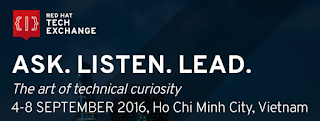Coming up next week in Ho Chi Minh City, Vietnam is the annual APAC Red Hat Tech Exchange conference. I have spoken at several of these events over the years and they remain one of the best venues to meet up with partners and Red Hat rock stars from all over the region.
As I previously mentioned, I submitted several talks to this event and though they all were accepted I am unable to attend personally due to transitioning from the US back to Europe. This is a big move and I could not really find time to head over to Asia for this conference.
The good news is I planned in advance and found a most excellent replacement in Andrew Block, probably the most talented Principle Consultant at Red Hat I have ever had the pleasure of working with. He is an avid traveller, coder, technology enthusiast and just plain fun guy to talk with.
A little bit about Andrew: He's a Principal Consultant from the Central region of the United States who specializes in OpenShift, Integration and Continuous Integration and Continuous Delivery. He is a core member of the Enterprise Integration and Container & PaaS Community of Practices (CoP) and frequently writes about his experiences working with open source technology.
We have spent some time over the last weeks working on the stories we want to share with you in Vietnam next week. While you will have to attend to hear the stories live, to experience the demos that Andrew will be rocking live on stage, for now you can see the presentations that will be used.
Without any further delay, here are the three sessions you don't want to miss at the Red Hat Tech Exchange 2016:
I hope you enjoy these sessions and let both Andrew and myself know what you think?
As I previously mentioned, I submitted several talks to this event and though they all were accepted I am unable to attend personally due to transitioning from the US back to Europe. This is a big move and I could not really find time to head over to Asia for this conference.
The good news is I planned in advance and found a most excellent replacement in Andrew Block, probably the most talented Principle Consultant at Red Hat I have ever had the pleasure of working with. He is an avid traveller, coder, technology enthusiast and just plain fun guy to talk with.
A little bit about Andrew: He's a Principal Consultant from the Central region of the United States who specializes in OpenShift, Integration and Continuous Integration and Continuous Delivery. He is a core member of the Enterprise Integration and Container & PaaS Community of Practices (CoP) and frequently writes about his experiences working with open source technology.
We have spent some time over the last weeks working on the stories we want to share with you in Vietnam next week. While you will have to attend to hear the stories live, to experience the demos that Andrew will be rocking live on stage, for now you can see the presentations that will be used.
Without any further delay, here are the three sessions you don't want to miss at the Red Hat Tech Exchange 2016:
Four stories for the Red Hat Cloud Suite
This session will highlight the four stories you tell when looking to help your customers and partners move into the Red Hat Cloud Suite for their cloud infrastructure. During this session you will learn to tell the stories for IT Optimization, Modernizing Development and Operations, Accelerating Service Delivery and Scaleable Infrastructure. These stories are backed with content, examples and videos that help you to become a professional Cloud Suite storyteller!Using the Red Hat Container Development Kit (CDK)
As a field resource, either pre-sales or post-sales, you can make good use of the Red Hat Container Development Kit (CDK). As pre-sales it is the ultimate tool for running local Cloud-based example projects in a fully automated, low touch, easy to install OpenShift Container Platform. As post-sales you will have a great environment to prototype your solutions and a playground for your customer engagements. I will take you on a tour of how to get started and you will leave with a fully installed Red Hat CDK environment on your personal machine. Get started the minute you leave this session with Red Hat CDK to explore examples of Red Hat middleware solutions, application development and wow your customers with how easy the Cloud can really be!Get your App Dev on in the Cloud
There is a lot of hype around Cloud infrastructure at Red Hat with the introduction of product solutions like Red Hat Cloud Infrastructure (RHCI) and Red Hat Cloud Suite (RHCS). What does this mean for your customers that have to develop application on this Cloud infrastructure? In this session you will be given a growing toolbox of examples, how-to’s and video pointers so that you can tell a story around application development in the Cloud. By the end of this session you will be able to answer the question, “Why can’t I ignore the stack anymore?”I hope you enjoy these sessions and let both Andrew and myself know what you think?












